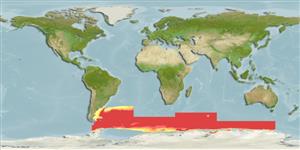Environment: milieu / climate zone / depth range / distribution range
Ökologie
seewasser bathypelagisch; tiefenbereich ? - 2050 m (Ref. 58018). Temperate; 37°S - 72°S
Western Atlantic: between 37°S and 72°S. Probably circumglobal in Antarctic waters.
Size / Gewicht / Alter
Maturity: Lm ? range ? - ? cm
Max length : 30.0 cm TL Männchen/unbestimmt; (Ref. 88797)
Kurzbeschreibung
Morphologie | Morphometrie
Afterflossenweichstrahlen: 24 - 27; Wirbelzahl: 75 - 82. This species is distinguished by the following characters: A 24-27, its origin at the hindmost fifth of SL; pectoral fin rays 10-11; origins of pelvic fins distinctly in front of a vertical from first dorsal fin ray; conspicuously modified lateral line; dorsal and ventral protrusions of each lateral line scale extend to dorsal and ventral midline, forming a transverse striation of the body; elongated and subcylindrical body; snout pointed and terminal, the upper jaw extending just below nasal aperture; base of adipose long (at least twice the height of the caudal peduncle); total vertebrae 75-82 (Ref. 88797).
Juveniles taken at 45 m; adults from 550 to more than 2, 000 m. Feeds on krill and fishes.
Life cycle and mating behavior
Geschlechtsreife | Fortpflanzung | Ablaichen | Eier | Fecundity | Larven
Post, A., 1990. Paralepididae. p. 138-141. In O. Gon and P.C. Heemstra (eds.) Fishes of the Southern Ocean. J.L.B. Smith Institute of Ichthyology, Grahamstown, South Africa. (Ref. 5176)
IUCN Rote Liste Status (Ref. 130435)
Bedrohung für Menschen
Harmless
Nutzung durch Menschen
Mehr Information
NamenSynonymeMetabolismusRäuberÖkotoxikologieFortpflanzungGeschlechtsreifeAblaichenSpawning aggregationFecundityEierEientwicklung
Alter/GrößeWachstumLänge-GewichtLänge-LängeLängenhäufigkeitenMorphometrieMorphologieLarvenLarven Pop.Dyn.RekrutierungDichteBRUVS
ReferenzenAquakulturAquakultur ProfilZuchtlinienGenetikElectrophoresesVererbbarkeitKrankheitenVerarbeitungNutrientsMass conversion
PartnerBilderStamps, Coins Misc.LauteCiguateraGeschwindigkeitSchwimmstilKiemenoberflächeOtolithsGehirngrößeSehfähigkeit
Tools
Zusatzinformationen
Download XML
Internet Quellen
Estimates based on models
Preferred temperature (Ref.
123201): 0.8 - 4.3, mean 2.1 °C (based on 193 cells).
Phylogenetic diversity index (Ref.
82804): PD
50 = 0.7500 [Uniqueness, from 0.5 = low to 2.0 = high].
Bayesian length-weight: a=0.00224 (0.00090 - 0.00555), b=3.14 (2.92 - 3.36), in cm total length, based on LWR estimates for this (Sub)family-body shape (Ref.
93245).
Trophic level (Ref.
69278): 3.9 ±0.62 se; based on food items.
Fishing Vulnerability (Ref.
59153): Low vulnerability (20 of 100).
Nutrients (Ref.
124155): Calcium = 42.5 [12.5, 124.3] mg/100g; Iron = 0.308 [0.093, 0.938] mg/100g; Protein = 16.2 [13.1, 18.8] %; Omega3 = 0.208 [0.054, 0.659] g/100g; Selenium = 18.9 [5.7, 62.3] μg/100g; VitaminA = 42.7 [4.5, 379.1] μg/100g; Zinc = 0.608 [0.310, 1.235] mg/100g (wet weight);
